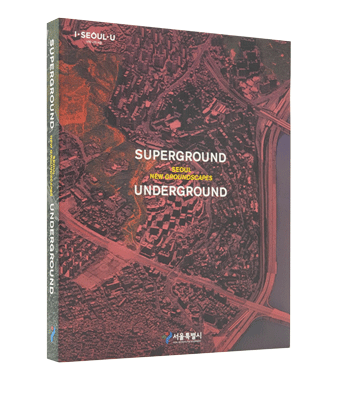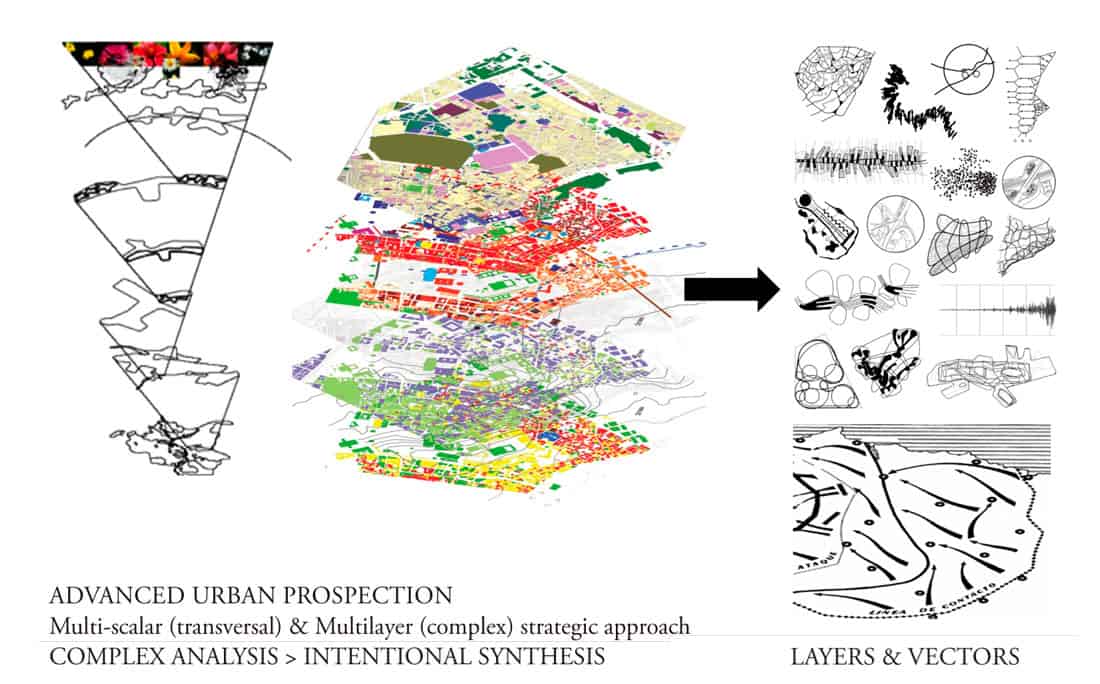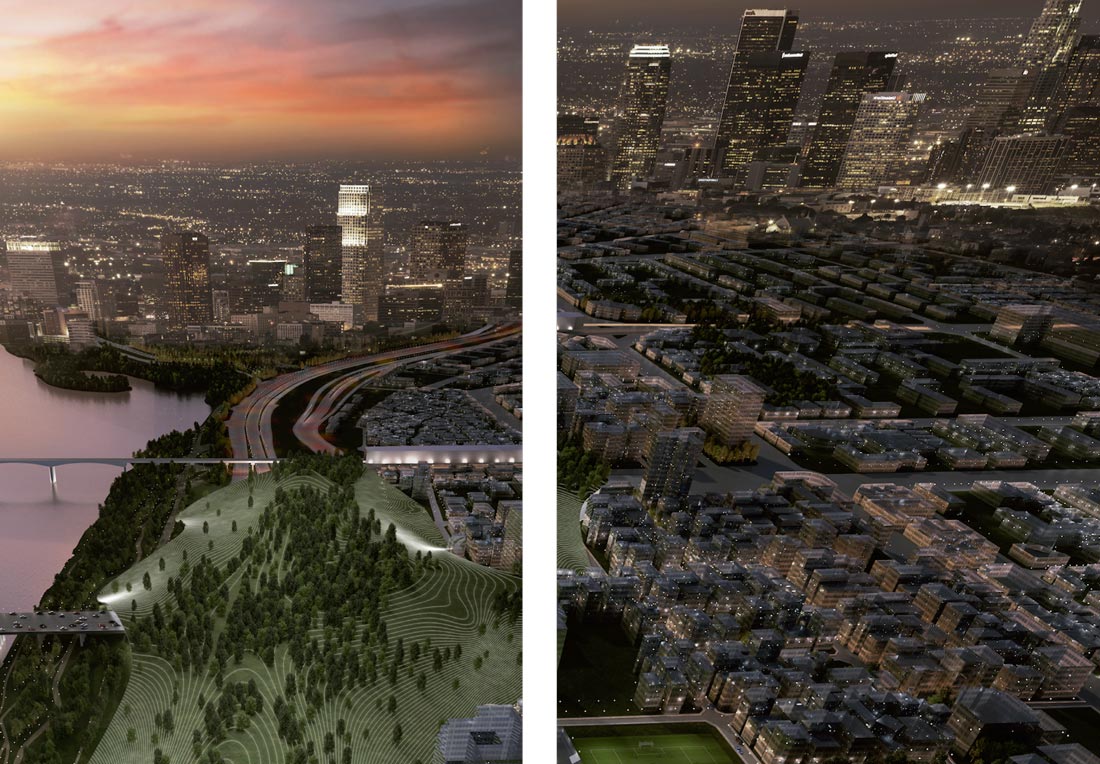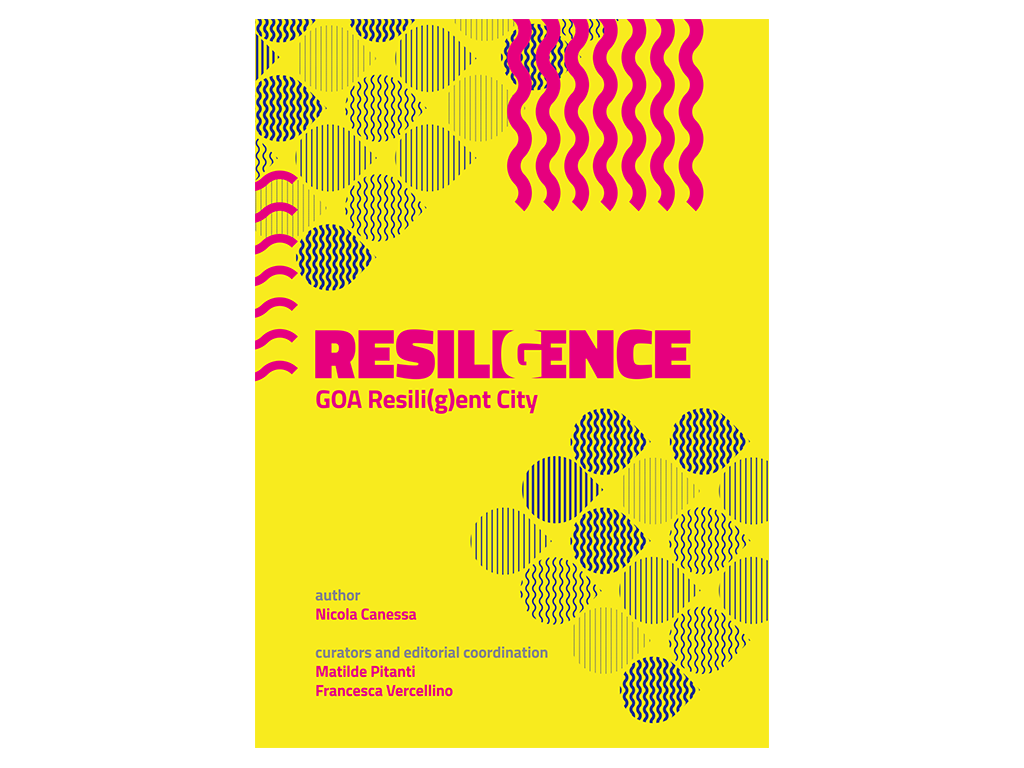The last few decades have confirmed the evidence of a spectacular change of scale (and paradigms) in the definition of our spaces of live and sociability – of our own habitats and our cities – linked with the accelerated increase in mobility and long-distance communication, the delocalization of exchanges, and the technological and material capacity of transformation of our environment.
A global process connected, also, with the digital rising capacity to combine overlapped and simultaneous parameters of information. The contemporary multi-city evidences, more and more, its dynamic and complex condition, that is the nature of a territorial and informational system.
In front of the impressive urban mutations and in front of the perplexity of the traditional disciplines for answering to all the implications of the new complex conditions, the urban cultures and governments of the cities in-between centuries have experimented different models:
— a first model (Revisionistic), specially present in the 70´and 80´, based in the recuperation of the history and the past. A retroactive and historicist model based in the urban recreation and the formal evocation of the postmodern cultures. “Coming back to the traditional city” would be the slogan of this kind of approach.
— a second model (Structuralistic ), very important at the end of the XXI century (80´and 90´) based in the materialistic and developistic extension of the cities and its arterial netting articulation. A “neo-modern” model based in the urban (super)planning, the standardisation of the referents and the efficiency of the traffic physical nets. “Towards a Metropolitan Dream” would be the second slogan of this kind of approach.
— a third model (Objectualistic / Mercantilistic), more recent (90´ and 2000´) based in the urban marketing and urban management of the cities, founded in the event positioning of iconic objects. A Post, Neo & Para-modern model, associated to the objectual design (iconic), the importation of big firms, the branding, the architectural glamour, and its to signification by the (same) implantation recognizable elements. “The city as a branding-mark” would be the slogan of this third of approach.
All these models (revisionistic or structuralistic, objectualistic or mercantilistic, iconic or rhetoric) have revealed themselves as closed in a self-referential spiral of old urban forms and formulas not able to confront the challenges of a new informational time associated to the digital revolution and the multiple and complex logics of the today’s n-City understood as a new multi-relational and open environment.
A new model (or better, criterion of action) seems today necessary to be explored: a prospective model able to understand the city as a dynamic and plural system linked with evolutionary and in-progress processes.
If, from the beginnings of the XXI Century, the revolutions of the new informational and computational era have increased the complexity and heterogeneity of our urban environments, a new advanced urban logic (based in the innovative research and prospection), seems more and more necessary.
An advanced logic called to work with the duality Information + Interaction, favouring the emergence of new urban strategies connected with the research of anticipatory holistic recognitions – and visions – able to combine multiple layers of simultaneous realities, integrating data-conditions, data-orientations and data-visualisations in new more empathic and responsive and proactive answers.
Beyond the past recuperation, the structural standardisation or the iconic importation of referents, the important of this contemporary approach would be the generation of new operational referents
“Exploring new multi-layering and multi-interactive environmental strategies” could be the slogan of this advanced gaze.
The innovative inputs of new methodological urban approaches can be associated to three advanced lines of action, diverse but interconnected in-between them, that are opening the door not only to different changes of paradigms but also to new frameworks, instrumental and technological tool-applications and experimental outputs:
A – A digital (& data-processing) technological innovation linked with the informational management and the new dynamics of open-source programs, real time data and smart-cities parametrisation and sensorisation.
B – An integrative ands eco-systemic innovation who expresses an important change of paradigms –from old land-uses planning to new land-networked strategies– able to integrate complex layers and structures in new networked, relational (and operational) scenarios and systems.
C – A social (& bottom-up) creative innovation connected with new forms of participation and co-production –and with a new kind of social “civilities” and collective behaviours– shared in a new kind of relational spaces (and structures) able to favour multiple interactive experiences. These are some of the new conceptual orientations in relation with a new possible Advanced Urbanism.
A new urbanism that must to combine Precise DATAS & holistic VISIONS.
Such combination “information + vision” (processing capacity and prospective, strategic and relational capacity) lacks today of suitable reference areas and ambitious programs of inter-disciplinary exchange.
If we understand the new logics – associated to a new urban thinking – in relation with the challenges of these new informational era – and the capacity, in this one, to multiply the interactions between realities and conditions and information(s) – we need to understand also in what terms we define “information”, not only as a data-parameter or a data-indicator but as a more enlarge concept associated to other assimilated key-terms (programs, solicitations, messages, patterns, identities, matters, cultures, types, behaviours, senses, networks, natures, morphologies and metabolic contexts) able to be combined in (and from) new –and more– open, flexible and contemporary urban systems.
New Urban Challenges
The new generation of urban planners is challenged to find solutions to complex problems related to population, energy, environment, food, water, security, housing, health, and transportation. But also to a new rational land-use, a sustainable growth and infrastructural development linked with a new kind of conception of the public and civic space, providing new strategic scenarios no longer productive or reproductive but “co-productive”: scenarios capable of generating open and intelligent solutions, orientated and adaptable at a time, connected with the new main global challenges and topics that seem to conform, today, the must substantial paradigms of our contemporaneity:
— The new territorial and land-articulations of the region-city and their translation in new demands of re-naturalisation and a new valorisation of the landscape as a structural factor associated to a new environmental sensibility in the land-use developments.
— The new active dimension of the public space as an operational and relational space at a time. The increase of smart and responsive data applications and its relationship with a new kind of interactive public “interfaces associated, at a time, with a new re-naturalisation urban demand.
— The new conception of the mobility (efficient, speed and slow at time) and the conception of the different infrastructures in new integrated models.
— The importance of the urban recycling and the reuse of the pre-existences.
— The new capacities to mix uses, functions and programs in a new kind of tri-dimensional built repertories and n-densified hybrid typologies.
— The new sustainable agendas (energetic (self)sufficiency, intelligent management of resources, etc.) and their translation into new types of eco-habitats.
— The resilient capacity of the cities in new flexible and adaptable strategies.
— The importance of the coastal and river-rives consideration and, in this sense, the importance of the water-fronts treatments.
— The increase of the tourism and its incidence in the new society of leisure and knowledge and the relevance of the urban attractors.
— The importance of the combination between culture and innovation, heritage and patrimonial values and creative and generative platforms and spaces.
Topics and challenges that –specially in the case of Seoul– can be synthetized in five binomial key-vectors involved in and with new relational scenarios:
— Integrated infrastructures and new interactive public spaces, that is:
—— Multi-centrality and connectivity: integration of land flow and slow infrastructures in new plural and diversified systems of mobility.
—— Conception of a new type of interactive networks for public spaces understood as new active interfaces
— Urban re-naturalization and landscape factor, that is:
—— Natural urban corridors and meshed green-structures.
—— Landscape interaction: multi-layered borders (river waterfronts, mountain frictions) and diversified topos.
— Urban Recycling and new tri-dimensional density and mixicity, that is:
—— Urban and infrastructural recycle: reviving and reactivating processes for the traditional and/or existing city (and its super and infra structures).
—— Diversity of uses, functions and programs in a new kind of tri-dimensional hybrid typologies and/for habitats.
— Eco-systemic management and resilient adaptability, that is:
—— Sustainable agenda: sustainable and spatial welfare environments associated to new co-participatory and responsive processes.
—— Resilience: adaptable urban ecosystems.
— Touristic development, urban knowledge attractors, cultural values (heritage and innovation), that is:
—— Tourism: citizen exchange in touristic old (and new) attractors
—— Heritage & knowledge: dynamic cultural, but also creative and innovative knowledge.
In front of these cha(lle)nge-paradigms (associated the complex processes of urban mutations – and competitions – in-between cities… and centuries) the new urban leaderships require to combine efficiency and imagination, pragmatism and creativity, own culture and transversal cosmopolitism, trough new vectors of qualitative developing able to conduct and orientate the processes in a sustainable, progressive and innovative way: new technological and digital capabilities and new processes of innovative conception and prospection, aimed to combine urban data-processes and urban creative-visions in new holistic strategies, landed – in the case of a new ambitious Seoul urban program– in referential and concrete key-operations: new compressing – and condensing – scenarios, able to integrate new urban global challenges and local sites (and situations).
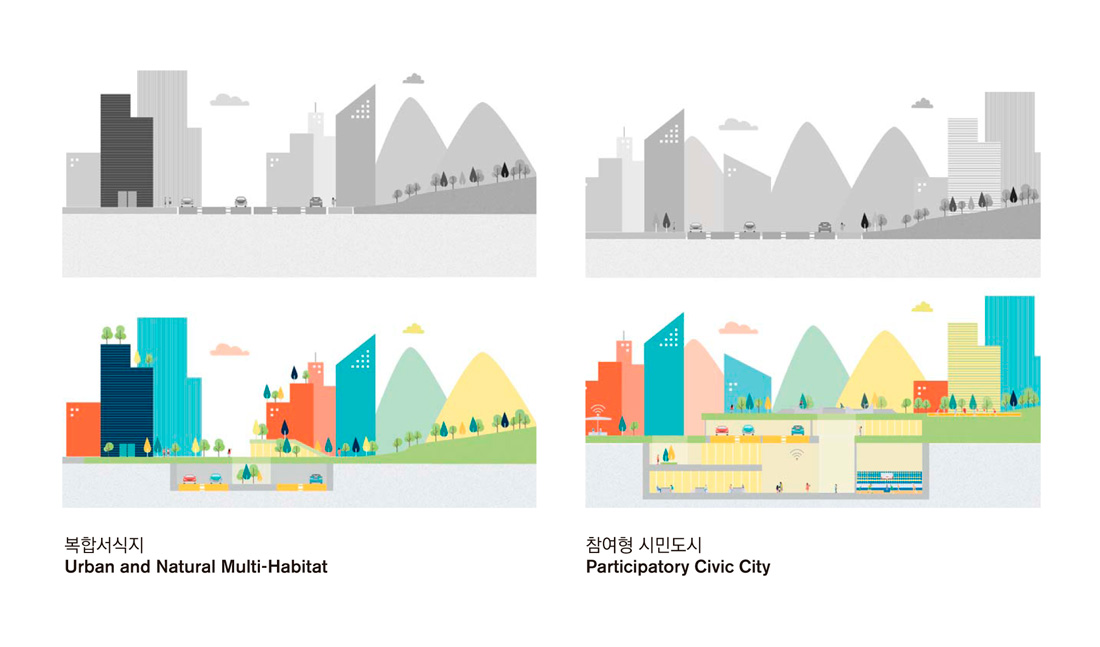
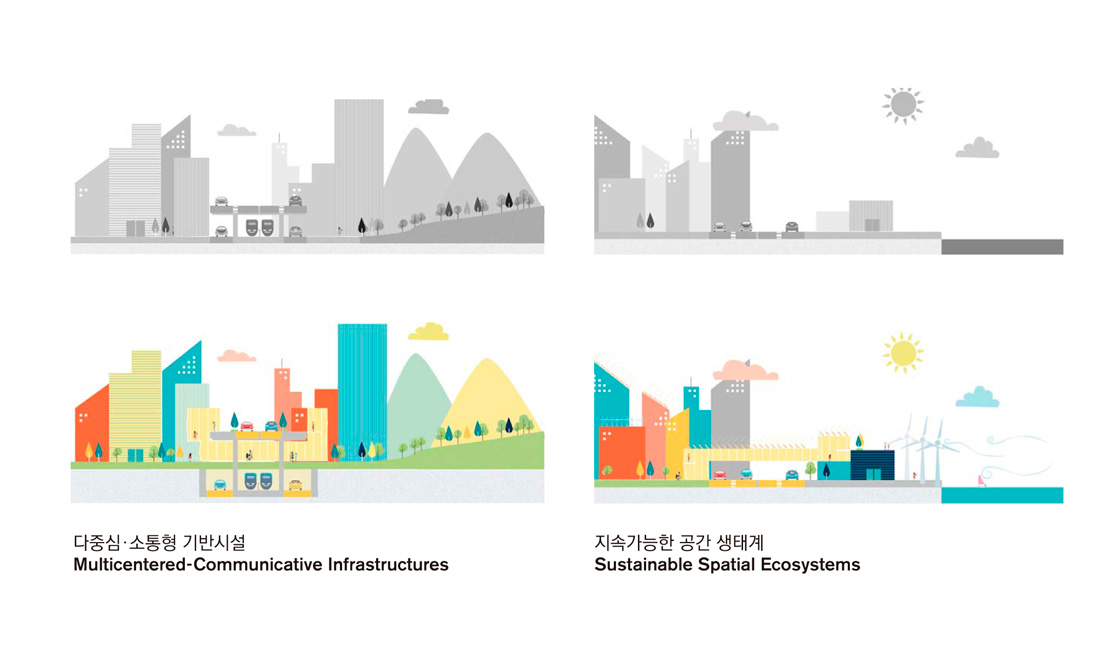 Seoul: Living Infrastructures, Condensing Civilities
Seoul: Living Infrastructures, Condensing Civilities
The interest and singular specificity of Seoul –as a potentially new metropolitan referential context– is the capacity for the city to combine and manage all these new urban paradigmatic challenges that are defining our contemporary multi-cities, in a mixed reality able to condense all them in a new kind of urban conviviality (urban sharing, urban integration, urban relationship, urban interaction, etc.) called to conjugate urban density and interactive civility.
This civil vector marks the new orientation of the Seoul last years urban development where the city appears as a new dense civic-city, directly associated to the socio-environmental and programmatic reorientation of its old structures (and infrastructures).
In fact, the big potential of Seoul is based in its infrastructural immanent network of matrixes, meshes, arterial lines and nodes that, in the new urban politics of the city, are called to be re-conduced and re-orientated. A multi-infrastructural network where is possible, today, to detect hot-points, areas of opportunity (and social operability) where the city can experiment a new reset.
Spaces linked with old infrastructures re-interpreted, today, as new intra-structures.
Eco, info and meta structures, also, that express this super-grounding dimension for a new SeYoul (a “you-city”, convivial, collective and connected).
Singular spaces for singular operations linked with these new urban and infrastructural targets of mixed urban programs able to be developed in each sector, housing and living, relational and convivial, productive and exchanging, leisure and knowledge spaces, combined with different degrees of intensity and capacity of growing and evolution.
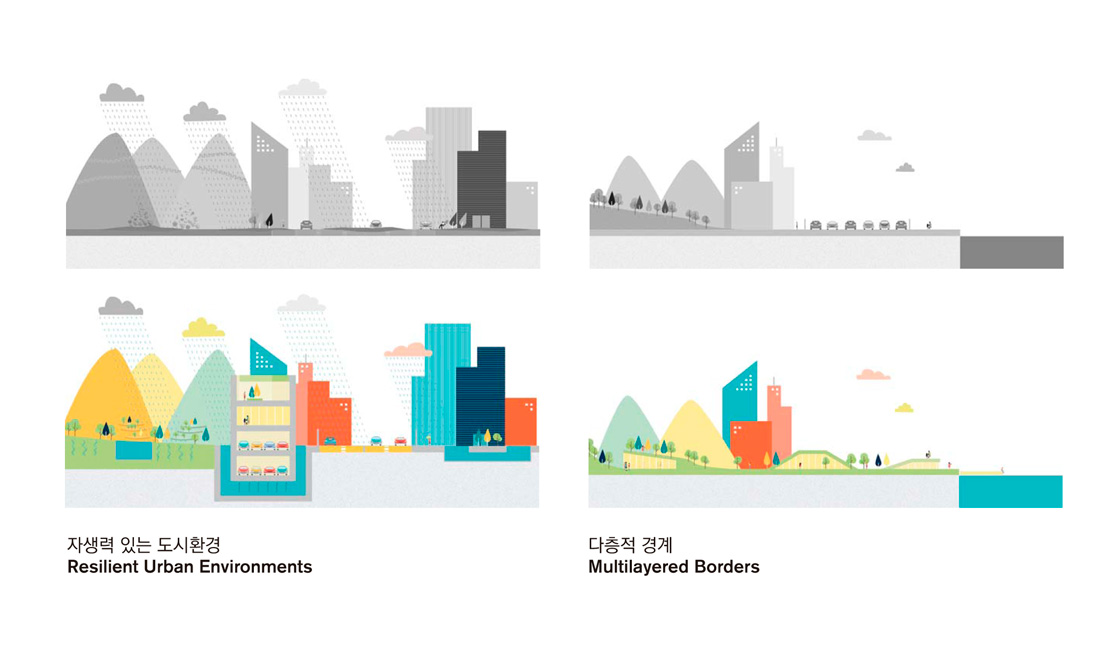
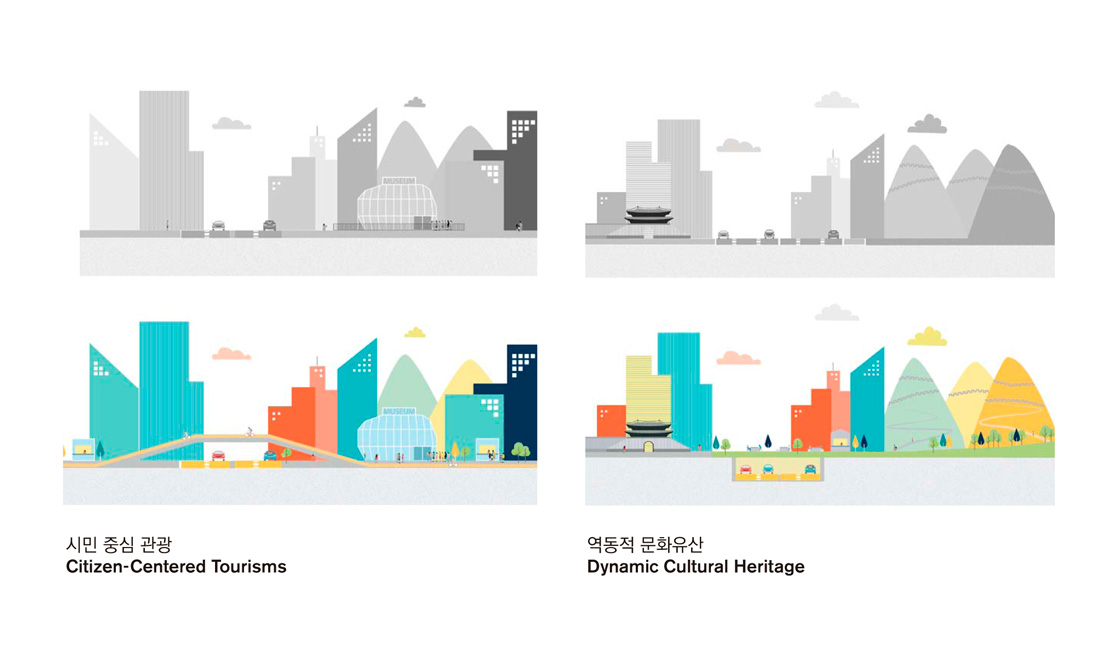 Multilayer Prospection Upper and Under Grounds
Multilayer Prospection Upper and Under Grounds
To conceive the territory as a multiple scenario of interchange and simultaneity would, in fact, refer to a new look at the traditional tools of planning and development of the ground, a look destined to re-evaluate its old formulations. A more complex city (subject to responding to the current overlapping of levels of interpretation, activity and life) should be faced, preferably, through different levels of use and definition, starting from a “qualification” of the land based no longer on two-dimensional zoning and mono-functional classifications (residential areas, industrial zones, green areas, etc.), but rather on “n-dimensional” criteria; combining levels and layers of use and programming with and in new integrated three-dimensional mixed operations where to establish new areas of interaction between traditionally separate categories (natural and artificial, landscape and architecture, residence-production-recreation, housing and equipment, etc.) activated not only through simple connections but interconnections and/or interweaving relationships.
Overcoming the inertia of traditional vision, based on 2D plans and +0 levels, for a new 3D vision (and 4D, incorporating the time dynamic factor) attentive to the potential of recent technological tools associated to with a new “hybrid” designing approach capable to couple – and synthesize – surfaces and volumes, horizontality and verticality, soils and subsoils in a new three-dimensional-vision made of complex programmatic sections aimed at favoring, as mentioned, the creative and qualitative revaluation of certain strategic and infrastructural sites, appropriately recycled and “re-informed”.
The concept of n-ground or multi-ground (Superground or Underground) responds to these criteria: it does not intend to “continue” or “recreate” the traditional city. Nor impose or position, transforming it, built machines or objects (re-objectualizing the urban plot) but superimpose (with all associated synonyms, cover, overlap, infiltrate, slide, interspersed …) a new dense floor (container and articulator at the same time) that becomes a new topos on, inside, in, where and through which to develop new/old programs, uses and activities of life and relationship.
A new floor able to maintain a programmatic thickness and also become a new type of relief, platform or revea in length and height, horizontally and vertically at the same time: a new floor capable of merging landscapes, infrastructure and building in a new type of systems/devices variable and adaptable to the current urban and environmental conditions.
Obviously the opportunity areas of the old infrastructures (some in operation, others obsolete or in disuse) are revealed as the ideal spaces to support (to incorporate and to structure) these new floors, real and virtual at time.
